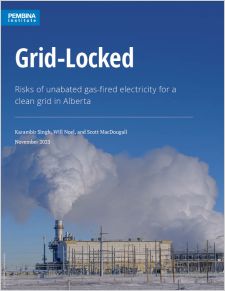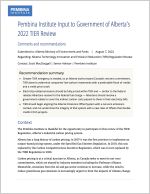
Alberta’s electricity sector has been undergoing significant changes in recent years. In the last five years, the province has retired nearly 87% (5.4GW) of its coal fleet, while nearly quadrupling its wind and solar capacity during the same period. Consequently, greenhouse gas (GHG) emissions from the electricity sector declined by 8.3Mt between 2018 and 2021 in Alberta.
However, Alberta is still responsible for nearly half of Canada’s electricity emissions and lags the rest of the country in reducing its emissions profile. Emissions from gas-fired generation made up nearly half of Alberta’s electricity sector related emissions in 2021 and are rising due to new investments in unabated gas-fired generation. Gas capacity is expected to increase by nearly 24% in Alberta over the next two years, and gas-fired electricity could emit as much as 20.9 Mt CO2e in Alberta in 2035. Unless Alberta takes a different approach, the province’s electricity sector emissions could be nearly double that of what the Pembina Institute’s low-carbon analyses have found is possible for a net-zero grid in 2035— making it much harder to achieve economy wide carbon-neutrality by 2050.
Gas-fired electricity can remain a part of a modernized, low-carbon electricity mix if emissions are captured (abated). In its 2023 report Zeroing In, the Pembina Institute found that a net-zero grid in Alberta could include between 1.8GW and 5.2GW of abated gas capacity in 2035. With the aforementioned planned gas capacity expansion — much of which is new unabated gas plants, and five gas plants (existing and new) with carbon capture projects being explored or already announced—Alberta will have enough gas-fired electricity on its grid to meet its electricity needs. Building more gas projects that do not capture emissions will cement our dependency on an emissions-intensive source of electricity and puts Albertans at risk of covering the costs of stranded assets while making it difficult for Alberta to achieve an affordable and reliable net-zero grid.
Policy and regulatory certainty along with incentives such as the proposed carbon capture, utilization and storage and clean electricity investment tax credits (ITC) are critical for enabling clean energy development, including abated gas. For Alberta to achieve an affordable, reliable, and clean grid by 2035, the Pembina Institute offers the following recommendations:
-
Restrict building gas plants that do not have carbon capture and storage (CCS) and prioritize retrofitting CCS at existing unabated gas-fired generation. Alberta already has enough existing unabated gas plants to meet its needs through to 2035 under current and proposed regulations. Priority should be given to retrofitting existing unabated generation sources where practical and cost-effective before constructing new projects.
-
Invest strategically in gas-fired electricity with carbon capture and storage. Generators can soon leverage the draft carbon capture, utilization and storage ITC, and in the future may be able to use the proposed clean electricity ITC. However, a diverse generating fleetis needed, as overdependence on CCS could inflate costs for consumers while diverting public funds away from other critical abatement options (e.g. energy efficiency, transmission infrastructure).
-
Strengthen provincial carbon policiesfor electricity. Alberta’s Technology Innovation and Emissions Reduction (TIER) Regulation defines a high-performance benchmark for electricity generation — currently set at 370 t/GWh and declining at a rate of 2% per year — that dictates the volume of electricity emissions that bear a cost from carbon pricing. The Pembina Institute recommends that the electricity benchmark is removed or reduced to 0 t/GWh by 2035. This will ensure all electricity emissions are subject to carbon pricing, providing certainty for investments into clean electricity — including abated gas-fired electricity — and sending a clear economic signal to reduce sector emissions. This would complement the Clean Electricity Regulations by providing a mechanism to offset residual electricity sector emissions with credits or offsets.
-
Accelerate the development of affordable and provenclean energy options. Government support, both financial and through enabling policies and regulations, for technologies including wind, solar, battery storage, energy efficiency and inter-regional transmission interties will accelerate the transformation. Support is also needed to de-risk early investments in the strategic deployment of longer-term energy storage to help push Alberta toward a decarbonized electricity grid.
-
Monitor consumer affordability. Finally, we also emphasize that, because energy affordability is a serious issue facing Canadians, government should proactively monitor affordability while we transform the electricity system, so they can more quickly address any issues that might arise.


